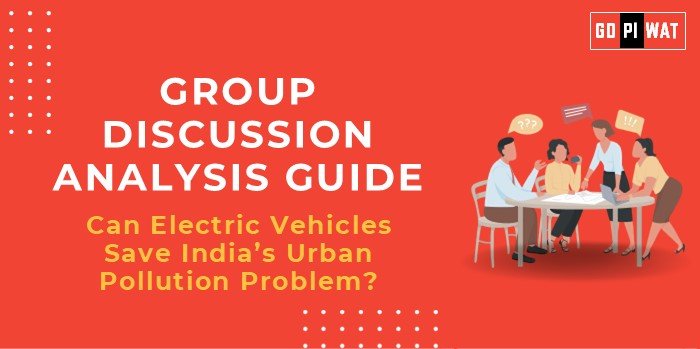📋 Group Discussion (GD) Analysis Guide: Can Electric Vehicles Solve India’s Pollution Crisis?
🌐 Introduction to Electric Vehicles (EVs) and Pollution in India
- Opening Context: “India’s pollution levels are among the highest globally, with transport emissions contributing significantly. Electric vehicles (EVs) present a promising solution to tackle air quality challenges and reduce carbon footprints.”
- Topic Background: The push for EV adoption gained momentum with India’s target of achieving 30% EV penetration by 2030 under the FAME II scheme. Globally, EVs are seen as critical to mitigating climate change.
📊 Quick Facts and Key Statistics
- 🚗 Transport Sector Contribution: Accounts for 27% of India’s carbon emissions.
- 📈 EV Sales Growth: Over 1.17 million EVs sold in FY 2023, marking a 155% year-on-year growth.
- 🔋 Battery Cost Trends: Lithium-ion battery prices dropped by 89% since 2010 globally, making EVs more affordable.
- 💰 Government Incentives: ₹10,000 crore allocated under FAME II for EV adoption.
- 🌫️ Air Quality Stats: 63 cities in India exceed WHO air quality guidelines annually.
🤝 Stakeholders and Their Roles
- 🏛️ Government: Policy support through subsidies, infrastructure development, and incentives.
- 🏭 Private Sector: Investments in EV manufacturing and charging networks.
- 🚙 Citizens: Adoption of EVs for daily commutes.
- 🌍 Global Organizations: Support through funding and technology sharing (e.g., World Bank, UN).
🏆 Achievements and Challenges
✨ Achievements
- 📊 Rising EV Adoption: FY 2023 saw a record in EV sales.
- 🔌 Charging Infrastructure Expansion: 2,700+ public EV charging stations installed.
- 📜 State-Level Policies: States like Maharashtra and Delhi introduced progressive EV policies.
⚠️ Challenges
- 💸 High Upfront Costs: EVs remain unaffordable for many.
- 🔋 Battery Dependency: Reliance on imported lithium and cobalt.
- 🏞️ Infrastructure Gaps: Limited charging stations in rural and semi-urban areas.
🌍 Global Comparisons
- 🇳🇴 Success – Norway: Achieves over 80% EV penetration.
- 🇺🇸 Challenges – USA: Struggles with equitable charging infrastructure.
📖 Case Studies
- 📜 Delhi EV Policy: Incentivized purchase of EVs, leading to a 12% rise in EV registrations.
📚 Structured Arguments for Discussion
👍 Supporting Stance:
“EVs reduce transport emissions drastically, aligning with India’s Paris Agreement targets.”
👎 Opposing Stance:
“The energy grid’s dependency on coal undermines the green potential of EVs.”
⚖️ Balanced Perspective:
“While EVs promise reduced emissions, a transition to renewable energy is critical for holistic impact.”
🗣️ Effective Discussion Approaches
🚀 Opening Approaches
- 📊 Start with Statistics: “Transport emissions contribute 27% of India’s total carbon emissions…”
- 📜 Highlight Policy: “FAME II has catalyzed EV adoption in India, but…”
🛠️ Counter-Argument Handling
- 💡 Highlight data-backed rebuttals (e.g., renewable energy integration plans).
📈 Strategic Analysis of Strengths and Weaknesses
- 💡 Strengths: Government incentives, lower running costs of EVs.
- ⚠️ Weaknesses: High battery costs, lack of charging stations.
- ✨ Opportunities: Growth of renewable energy, global EV leadership potential.
- ⚡ Threats: Raw material dependency, policy inconsistencies.
🎓 Connecting with B-School Applications
- 📂 Real-World Applications: EVs can inspire projects in operations (supply chain optimization) and marketing (consumer adoption strategies).
- 🧐 Sample Interview Questions:
- “What are the economic implications of EV adoption in India?”
- “How can public-private partnerships accelerate EV infrastructure?”
- 🌟 Insights for B-School Students: EV adoption opens avenues for innovation in logistics, finance, and sustainability-focused startups.


